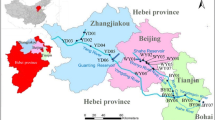Abstract
The pathogen indicator organism means pathogen associated non-pathogenic microorganisms for easier identification of the contamination. The pathogen indicator organisms can be used for estimating the impacts of non-point source pollution as their concentration is flow rate dependent. This study aims to determine the concentration of the pathogen indicator organisms in the Geum River basin and to understand the impacts of the non point source pollution on the water quality. In this study, total coliform, fecal coliform, andEscherichia coli concentrations were monitored at eight sites in the Geum River Basin. Total coliform concentration showed a high correlation with the flow rate, and a tendency of higher concentration for more agricultural land use in a monitored area. From the analysis of the relationship between flow rates and contaminant loads or concentration, two curves explained the relationships for the low flow and high flow conditions, respectively. Load duration curves were developed to estimate the impact of non-point source pollution on the water quality. From the load duration curve analysis, it can be understood that the water qualities of the Geum River are affected by non-point pollution significantly compare to the magnitude of point source pollution.
Similar content being viewed by others
References
APHA. AWWA, WEF. (1998).Standard Methods 20 th ed. Washington.
Behrendt, H. (1993). “Separation of point and diffuse loads of pollutants using monitoring of rivers.”Wat. Sci. Tech., Vol. 28, No. 3, pp. 165–175.
Borst, M. and Selvakumar, A. (2003). “Particle-associated microorganisms in stormwater runoff.”Water Research, Vol. 37, pp. 215–223.
Brezonik, P.L. and Stadelmann, T.H. (2002). Analysis and predictive models of stormwater runoff volumes, loads, and pollutant concentrations from watersheds in the Twin Cities metropolitan area, Minnesota, USA.Water Research, Vol. 36, pp. 1743–1757.
Conboy, M.J. and Goss, M.J. (2000). “Natural protection of groundwater against bacteria of fecal origin.”J. of Contaminant Hydrology, Vol. 43, pp. 1–24.
Gardi, C. (2001). “Land use, agronomic management and water quality in a small Northern Italian watershed.”Agriculture, Ecosystem and Environment, Vol. 87, pp. 1–12.
Howell, J.M., Coyne, M.S., and Cornelius, P.L. (1995). “Fecal bacteria in agricultural waters of the Bluegrass region of Kentucky.”Journal of Environmental Quality, Vol. 24, pp. 411–419.
Howell, J.M., Coyne, M.S. and Cornelius, P.L. (1996). “Effect of sediment particle size and temperature on fecal bacteria mortality rates and the fecal coliform/fecal streptococci ratio.”J. of Environ. Qual., Vol. 25, pp. 1216–1220.
Lipp, E.K., Farrah, S.A., and Rose, J.B. (2001). “Assessment and impact of microbial fecal pollution and human enteric pathogens in a coastal community.”Marine Pollution Bulletin, Vol. 42, No. 4, pp. 286–293.
Lisle, J. (1993).An operator's guide to bacteriological testing, American Water Works Association, Denver, 123pp.
Martins, M.T., Sato, M.I.Z., Alves, M.N., Stoppe, N.C., Prado, V.M., and Sanches, P.S. (1995). “Assessment of microbiological quality for swimming pools in South America.”Water Research, Vol. 10, pp. 2417–2420.
Maul, J.D. and Cooper, C.M. (2000). Water quality of seasonally flooded agricultural fields in Mississipi. USA.Agriculture Ecosystems & Environment, Vol. 81, pp. 171–178.
Novotny, V. and Olem, H. (1994).Water quality: prevention, identification, and management of diffuse pollution. Van Nostrand Reinhold, New York, 1054pp.
Schillinger, J.E. and Gannon, J.J. (1985). “Bacterial adsorption and suspended particles in urban stormwater.”J. Water Pollut. Cont. Fed., Vol. 57, pp. 384–389.
Steets, B.M. and Holden, P.A. (2003). “A mechanistic model of runoffassociated fecal coliform fate and transport through a coastal lagoon.”Water Research, Vol. 37, pp. 589–608.
Thomann, R.V. and Mueller, J.A. (1987).Principle of Surface Water Quality Modeling and Control, Harper & Row, New York.
U. S. Environmental Protection Agency, (1984).Health effects criteria for fresh recreational waters. EPA 600/1-84-004, United States Environmental Agency, Washington, DC. 33pp.
U. S. Environmental Protection Agency, (1993).Preventing waterborne disease. EPA/640/K-93/001, United States Environmental Agency, Washington, DC, 20pp.
U. S. Environmental Proctection Agency, (2001).Protocol for Developing Pathologen TMDLs. EPA 841R-00-002 Office of Water (4503F). United States Environmental Agency, Washington, DC. 132pp.
Whitlock, J.E., Jones, D.T., and Harwood, V.J. (2002). “Identification of sources of fecal coliforms in an urban watershed using antibiotic resistance analysis.”Water Research, Vol. 36, pp. 4273–4282.
Author information
Authors and Affiliations
Rights and permissions
About this article
Cite this article
Kim, G.H., Yur, J.H. Effects of the non-point source pollution on the concentration of pathogen indicator organisms in the Geum River Basin, Republic of Korea. KSCE J Civ Eng 8, 181–187 (2004). https://doi.org/10.1007/BF02829118
Received:
Accepted:
Issue Date:
DOI: https://doi.org/10.1007/BF02829118




